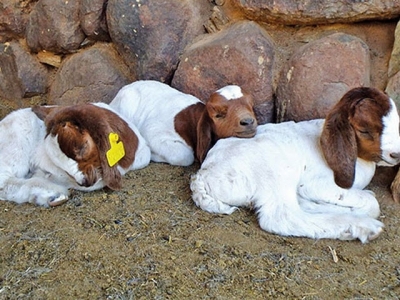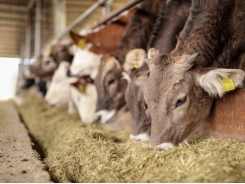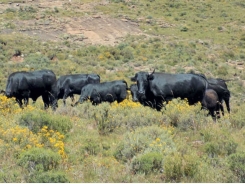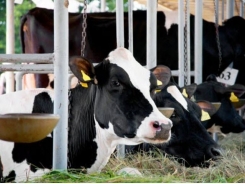How to raise Boer Goat kids

Boer Goat kids demand care and management for the first few weeks after birth. If you fail to look after them properly during this important stage, you could easily lose up to half of them.
Boer Goats offer many advantages: they’re an excellent source of meat and milk, resist disease, make good mothers, and adapt to difficult conditions. However, the kids demand care and management for the first few weeks after birth. If you fail to look after them properly during this important stage, you could easily lose up to half of them.
The Boer Goat ewe
Good care of the kids actually starts before they are born! In other words, you need to look after their mother, the ewe. So let’s start with her. If they get enough food, ewes can breed as early as six months of age.
However, you should not let them mate this young, as it can slow their growth and they might have trouble breeding again. Mate them only when they’ve reached two-thirds of the average body weight of the adult ewes in the herd.
Put the ram to the ewes for 36 days. Ewe comes into heat every 18 days, so 36 days will give each ewe two chances to conceive. Don’t leave the ram with the ewes for longer than this as he will become exhausted and unproductive. To ensure the best breeding results, do the following four to six weeks before mating takes place:
- Give the ewes zinc and manganese if required (your vet can advise you). This will make them more fertile.
- Immunise them against enzootic abortion and enterotoxemia, and dose them against roundworm and nose-worm.
- Cull any ewes with damaged or bunched teats, or teats that are too large.
- Inoculate the ewes against gangrene of the uterus eight to 12 weeks before they kid. This is extremely important as the disease can kill a ewe two or three days after kidding.
If you are unsure about any of these problems, seek advice from your vet or animal health practitioner. The ewes are pregnant for five months. Make sure they get enough food to gain 7kg to 9kg during the last six weeks of pregnancy. If they don’t eat properly at this stage, the kids will be born small and weak, and the ewes will not have enough milk for them.
The kidding season
Ewes with lambs can be kraaled in two ways:
- In one large pen: The entire herd – ewes and kids – are kept together, but the newborn kids stay behind when the ewes go out to graze. Although this is a widely used method, it has a serious disadvantage: the kids are very thirsty when the ewes return and rush to drink milk from any ewe. In the confusion, some kids may not get enough to drink while some ewes do not release all their milk.
- In small camps: This is a better method and is popular among farmers with bigger herds.
Between 10 and 20 pregnant ewes are placed in a camp with food, shelter and shade, and allowed to give birth in peace. They then remain here with their kids for two to three weeks. After this, the ewes and the kids both join the herd together. Whichever method you use, it’s important to ensure that each kid gets enough milk.
To do this easily, paint a number on each ewe and then paint the same number on her kids. This allows you to match the mothers and kids. If you have a small camp, walk among the ewes three times a day, placing the kids with their mothers and making sure each kid gets enough to drink. If you keep the kids in a single pen, use the numbers to match the kids with their mothers when the ewes return from grazing.
The kids
Ram kids should be weaned at 12 to 15 weeks and female kids and wethers (castrated rams) at 15 to 18 weeks. And ideally, they should be marketed when they are three to six months old. So, to breed the kids as easily and cheaply as possible, make sure there’s enough grazing for them for at least three months after weaning.
The kids will not put on much weight during the first 10 days after weaning. To make them gain weight, give them a ‘creep feed’ ration from the age of three weeks. (This will be discussed in the next issue.)
Diseases
There are two common diseases that can affect goats:
- Contagious exthyma (sore mouth). This causes small sores around the kid’s mouth, and can be transmitted from the lamb to the udder of the ewe, where it can result in sores and mastitis.
Severe cases can cause pain and weight loss among kids. After one to four weeks, the scabs dry up and drop off, and the animal gets better. Goats that have recovered like this are usually immune from further attacks. A vaccination is available and can be given to lambs one week and older. Take care! This disease can easily spread to humans and cause painful sores on the skin. Always wear gloves when working with infected animals.
- Heartwater. This is a potentially fatal disease spread by the bont tick. It is common in the coastal regions and in the northern and eastern parts of South Africa. Symptoms include a high fever, convulsions, trouble with walking, and chewing movements. The disease can be treated through regular dipping and antibiotics.
Sources: Production Parameters for Boer Goats in South Africa, dissertation submitted to the Faculty of Natural and Agricultural Sciences, Department of Animal, Wildlife and Grassland Sciences, University of the Free State, by Félix King; factsheet compiled by the department of agriculture in co-operation with ARC-Onderstepoort Veterinary Institute; The Boer Goat, by JC Scheltema of Elsenburg: Port Elizabeth extension; Boergoats South Africa
Related news
Tools

Phối trộn thức ăn chăn nuôi

Pha dung dịch thủy canh

Định mức cho tôm ăn

Phối trộn phân bón NPK

Xác định tỷ lệ tôm sống

Chuyển đổi đơn vị phân bón

Xác định công suất sục khí

Chuyển đổi đơn vị tôm

Tính diện tích nhà kính

Tính thể tích ao




 Heat-stressed dairy cows may see some benefits from…
Heat-stressed dairy cows may see some benefits from…  How to select a top-performing beef cow
How to select a top-performing beef cow